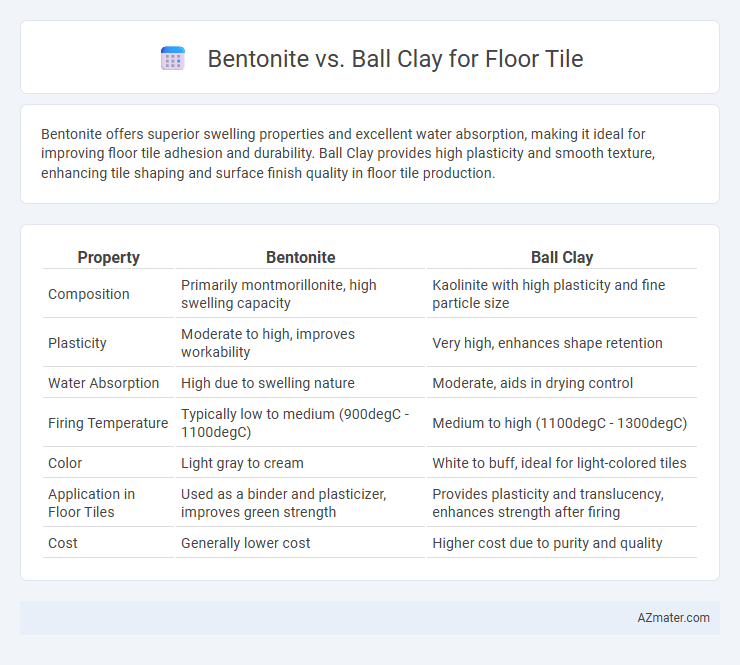Bentonite offers superior swelling properties and excellent water absorption, making it ideal for improving floor tile adhesion and durability. Ball Clay provides high plasticity and smooth texture, enhancing tile shaping and surface finish quality in floor tile production.
Table of Comparison
| Property | Bentonite | Ball Clay |
|---|---|---|
| Composition | Primarily montmorillonite, high swelling capacity | Kaolinite with high plasticity and fine particle size |
| Plasticity | Moderate to high, improves workability | Very high, enhances shape retention |
| Water Absorption | High due to swelling nature | Moderate, aids in drying control |
| Firing Temperature | Typically low to medium (900degC - 1100degC) | Medium to high (1100degC - 1300degC) |
| Color | Light gray to cream | White to buff, ideal for light-colored tiles |
| Application in Floor Tiles | Used as a binder and plasticizer, improves green strength | Provides plasticity and translucency, enhances strength after firing |
| Cost | Generally lower cost | Higher cost due to purity and quality |
Introduction to Floor Tile Clays
Bentonite and ball clay are essential natural clays used in floor tile manufacturing, each offering unique properties that influence tile quality and performance. Bentonite is prized for its excellent plasticity and water absorption, which enhances tile shaping and binding during the forming process. Ball clay contributes fine particle size and high plasticity, improving tile strength and surface smoothness, making both clays critical in producing durable, high-quality floor tiles.
What Is Bentonite?
Bentonite is a natural clay composed primarily of montmorillonite, known for its excellent absorption, swelling properties, and ability to bind particles together, making it valuable in floor tile manufacturing. It enhances tile durability and water resistance by improving the clay body's plasticity and structural integrity during firing. In contrast to ball clay, bentonite offers superior adhesive qualities, contributing to stronger, more resilient floor tiles.
What Is Ball Clay?
Ball clay is a highly plastic, fine-grained sedimentary clay composed mainly of kaolinite, mica, and quartz, essential for its excellent plasticity and strength in floor tile production. Unlike bentonite, ball clay provides superior binding properties and flexibility, which enhances the durability and finish of ceramic and porcelain tiles. Its unique composition allows for better shaping and firing processes, making it a preferred choice in manufacturing high-quality floor tiles.
Mineral Composition Comparison
Bentonite primarily consists of montmorillonite, a smectite group clay mineral known for its high swelling capacity and excellent plasticity, making it ideal for tile adhesion and durability. Ball clay contains kaolinite, mica, and quartz, contributing to its fine particle size, smooth texture, and high firing strength, which enhances the tile's hardness and surface finish. The distinct mineral compositions influence floor tile performance, where bentonite offers superior binding properties while ball clay provides improved structural integrity and aesthetic quality.
Plasticity and Workability Differences
Bentonite offers superior plasticity compared to ball clay, making it highly effective for improving the workability of floor tile clay bodies. Its ability to absorb water enhances the flexibility and shaping capabilities during tile forming processes, whereas ball clay provides moderate plasticity with a smoother texture ideal for fine detailing. In tile manufacturing, the higher plasticity of bentonite helps prevent cracking and warping, whereas ball clay contributes to a balanced extrusion and drying performance.
Impact on Tile Strength and Durability
Bentonite enhances floor tile strength by improving plasticity and reducing shrinkage during firing, resulting in durable, crack-resistant tiles. Ball clay contributes to tile hardness and density, boosting overall durability but may increase brittleness if overused. Optimizing the Bentonite-to-Ball Clay ratio ensures balanced tile strength and long-lasting performance in various flooring applications.
Shrinkage and Firing Behavior
Bentonite exhibits low shrinkage rates during drying and firing due to its high swelling capacity and plasticity, making it ideal for enhancing the workability of floor tile mixtures. Ball clay, characterized by moderate shrinkage and excellent plasticity, contributes to better green strength and firing stability but can cause higher shrinkage if used in excess. The firing behavior of bentonite typically results in improved mechanical strength and reduced glaze defects, while ball clay promotes vitrification and smooth surface finish, influencing the tile's final durability and dimensional stability.
Color and Appearance of Finished Tiles
Bentonite imparts a light gray to off-white hue to floor tiles, offering a matte and earthy appearance that enhances natural and rustic designs. In contrast, ball clay produces tiles with a creamy white to buff color, resulting in a smoother and more uniform surface finish ideal for polished and refined aesthetics. The choice between bentonite and ball clay directly influences the tile's final color tone and texture, affecting the overall visual appeal and design compatibility.
Cost and Availability Considerations
Bentonite tends to be more cost-effective than ball clay due to its widespread availability and lower extraction expenses, making it a preferred choice for budget-conscious floor tile manufacturers. Ball clay, while offering superior plasticity and strength for tile molding, is generally more expensive and less abundant, which can increase overall production costs. Availability of bentonite is higher globally, ensuring steady supply chains, whereas ball clay deposits are more geographically limited, impacting its consistent accessibility and price stability.
Choosing the Right Clay for Floor Tiles
Selecting between bentonite and ball clay for floor tiles hinges on their distinct properties and performance in ceramic production. Bentonite, rich in montmorillonite, offers excellent plasticity and water absorption, making it ideal for shaping and strength during drying. Ball clay, with its fine particles and high alumina content, provides superior plasticity and firing characteristics, resulting in durable, smooth tiles with less shrinkage.

Infographic: Bentonite vs Ball Clay for Floor Tile
 azmater.com
azmater.com